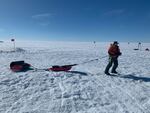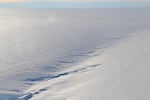One of the largest glaciers in the world is deteriorating at a rapid rate, and researchers from Oregon have found evidence that the glacier’s ice shelf could collapse within five years.
This collapse would have serious implications for future sea-level rise around the globe.
Antarctica’s Thwaites Glacier is about the size of Washington. Its deterioration is already responsible for about 4% of global sea-level rise. The Thwaites Glacier loses 50 billion tons of ice in the ocean every year. Like ice dropped into a glass of water, those glacier chunks cause the overall water level of the ocean to rise.
Researchers estimate that contribution would increase substantially when the glacier’s floating ice shelf breaks apart.

Oregon State University Glaciologist Erin Pettit studies Thwaites Glacier in Antarctica.
Karen Alley
“This 1,000 square kilometer section of ice, when it breaks up, it’s going to release a lot of resistance. It’s like a dam for that upstream ice,” said Oregon State University glaciologist Erin Pettit.
When the dam breaks, ice from higher elevations will flow down into the ocean — essentially more cubes dropped into the glass.
“This chunk of ice is holding up a dam that could, in a longer time frame — like in a century’s timeframe — contribute a couple of feet to sea level rise,” she said. “So we will get measurable sea level rise out of this over the next few decades.”
Pettit and her team used radar to map out weak spots in Thwaites’ ice shelf, the dam of floating ice at its ocean edge. They discovered a series of cracks and rifts that are rapidly spreading — at rates up to two miles per year. One is splitting apart the ice, with the leading edge of the crack heading directly towards a thinner section of ice where the researchers make their field camp.
“It’s a big crack. Six miles long and (all the way through) a third of a mile thick ice. It’s just a full-thickness fracture that’s opening up,” Pettit said.
When those cracks spread to this thinner section of ice and across the entire ice shelf, the researchers say the massive wall of ice will break apart. Pettit presented the findings this week at the fall meeting of the American Geophysical Union, an organization of scientists and science enthusiasts. Pettit says it’s still unclear how quickly the ice behind the dam will move once the dam is breached, but they expect it will pick up significant speed.
The deterioration of the glacier is being caused by increasing winds and a warming — both a consequence of climate change brought on by the burning of fossil fuels.
“Small changes in how warm the ocean is, or how the ocean currents are flowing around the ice, can have a pretty dramatic impact on the size of the glaciers,” says OSU glaciologist Kiya Riverman. “This glacier in particular — Thwaites — the ocean around it has warmed just a little bit, but that ‘just a little bit’ is enough to kick this glacier into changing really rapidly.”
Riverman studies Thwaites Glacier but was not part of the team that discovered the extensive fracturing. Over the past couple of years, she’s spent months encamped on the remote glacier in western Antarctica. But she says the cold wasn’t something that bothered her.
“To be honest I get colder biking to work in Corvallis on a cold, wet, rainy day where I forgot my gloves than I ever do in Antarctica — where you’re not about to forget your gloves at any point,” she says.
Riverman’s research involves the use of exploratory explosive charges and underwater robots to study how seawater below the ice shelf is affecting the glacier.

It doesn't look like much, but this snow-filled rift on Thwaites Glacier is one of several deep expanding cracks being tracked by OSU glaciologists. The cracks will eventualy contribute to the collapse of the glacier's ice sheet, which will drive sea level rise.
Erin Pettit
“Having some handle on exactly how warm the ocean is and where those currents are sitting with respect to the ice is what we use to drive our estimates of how this place is going to change in the future,” she said.
The ice of Thwaites Glacier is deeper than most glaciers in Oregon are long. Glacial melt in Oregon impacts how much water is available downstream for agriculture and communities. But Thwaites Glacier is on a different scale altogether.
“From a global perspective, these glaciers in Antarctica are just so, so huge that they have the ability to influence global climate and ocean circulation in a way that our mountain glaciers in our backyard don’t,” Riverman said.
The deterioration of Thwaites Glacier — and its contribution of two feet of sea-level rise over the course of a century — may seem like a problem for another generation. But the dire consequences of rising ocean levels will be felt long before 2121. Pettit says even a centimeter of sea-level rise can change erosion patterns, cause saltwater to move farther up into marshes, and change the impact of storm surges.
“When we talk about little bits of sea-level rise, every little bit is actually pretty important,” she said. “All of our coastal communities are trying hard to start to mitigate some of this stuff. But it’s going to be a challenge, and it’s not a challenge that’s going to go away anytime soon.”
